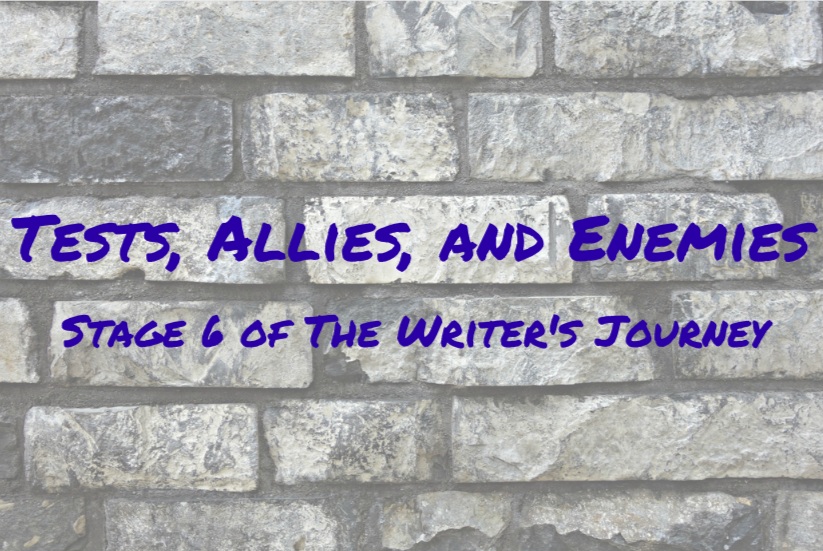Because everyone loves a good story
Stage Six: Tests, Allies, and Enemies

Who shot first: Han or Greedo?
Whether you have a strong opinion or couldn’t care less, that question probably still conjured up images of the cantina scene on Mos Eisley, didn’t it? This scene from Star Wars: A New Hope is a classic example of the “watering hole” scene in many adventure stories, and it’s a great introduction to Stage Six of the Hero’s Journey: Tests, Allies, and Enemies.
Remember, in Stage Five, the hero crossed the first threshold from the Ordinary World that he knew before to the Special World of the adventure. Christopher Vogler points out that “the audience’s first impressions of the Special World should strike a sharp contrast with the Ordinary World.” (135) Often (but not always), a “watering hole” scene is a great way for an author to showcase the shocking newness of the Special World. This could take place in a saloon, a cantina, or even a literal watering hole. Wherever people congregate in that world, that could be the perfect place to introduce the hero to some allies, enemies, and tests.
Allies, Enemies, and Tests
As the hero starts out in this new world of adventure, he’s going to need some allies. Allies can take several forms, Vogler explains, from new mentors and friends to a sidekick or even a whole team. The hero may pick up an unwelcome tagalong who becomes a helpful resource later on. (I reluctantly acknowledge Jar Jar Binks from Star Wars I.) The hero may be saved from a perilous situation by someone who becomes a friend. (I even more reluctantly suggest that if Star Wars I had been written from Jar Jar’s perspective, Qui-Gon Jinn would have been this kind of ally.) And some allies should be killed off almost immediately. (All right, I made that up, but it would have brought worldwide catharsis if Jar Jar had fallen over a cliff early on.) Anyway, there are countless ways the hero can encounter allies for the first time, so get creative!
But the story wouldn’t be much of an adventure if the hero just went around making friends; in this new world, the hero is sure to make enemies, too. Since it’s early in the story, the enemies may not be a life-threatening force yet. They may send warnings to the hero, search out her weaknesses, and begin to test her limits. Their presence reminds us that much is at stake.
As you know, Stage Six includes not only allies and enemies but also tests. “The Tests at the beginning of Act Two are often difficult obstacles, but they don’t have the maximum life-and-death quality of later events.” (136) This is not the place for the story’s ultimate showdown between Simba and Scar or Aladdin and Jafaar. Instead, this is where Simba gets spooked in the elephant graveyard and Aladdin gets chased for stealing food in the market. These tests are real threats, but they’re not critical. The story is still warming up.
Examples from The Hobbit
Now, I can’t think of a specific “watering hole” scene in The Hobbit (but 10 points to Gryffindor if you can find one). However, the book is absolutely laden with tests, allies, and enemies. Rather than condensing these into one chapter or scene, Tolkien prefers to spin it out into many, many, many pages. But let’s face it: if he didn’t, he wouldn’t be Tolkien, and we wouldn’t love him half so much.
For example, Bilbo and the dwarves are tested by three mountain trolls, meet some elves as allies in Rivendell, and get abducted by goblins. Then Bilbo stumbles across an enemy whose threat grows greater than Bilbo could have anticipated: Gollum. He undergoes more tests in the form of riddles. The party reunites only to be cornered by another pack of enemies, the wolves. They are rescued by some allies, the eagles, and then meet another ally, Beorn…. So as not to rehash every chapter, I’ll stop here. But I think you get the picture. There are many tests, allies, and enemies at this stage of the journey.
During this stage of the adventure, much takes place to intensify the plot and move along the action. While he or she makes allies, faces enemies, and passes tests, the hero is drawing nearer to the next important phase of the adventure: The Approach to the Inmost Cave.
Today’s Question: Think of a story that you enjoy. As the action was warming up, how did the hero encounter allies, enemies, and tests?
Sources
Vogler, Christopher. The Writer’s Journey: Mythic Structure for Writers, Second Edition. Studio City: Michael Wiese Productions, 1998.
Tolkien, J.R.R. The Hobbit. New York: Ballantine Books, 1937.

I’m going to use a sci-fi movie reference, but I really enjoy the Matrix for hero developemment. SPOILER ALERT. In the movie Neo starts as a programmer and is offered a chance to either keep living his life the way he’s always lived it or choose to know the truth about the world he thinks he knows and be changed forever. After he chooses option B he wakes up to reality. He then has to trust Morphious and Trinity to guide and train him in the new world. He makes allies and enemies and eventually one ally becomes an enemy. Overtime Neo learns how to “see” the Matrix and how to manipulate it against the enemy. The watering hole I believe would be when Neo wakes up in a pod and sees that all the other humans are grown in pods and the camera zooms out to show the world in run by machines, then Neo is pulled onto the ship of rebels and meets the new or “real world”.